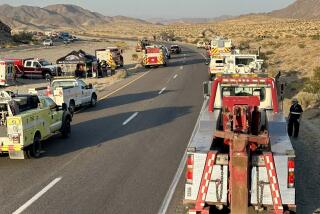Trucks That Move Over a Lane Do Others a Big-Rig Favor
- Share via
Dear Street Smart:
I have noticed that the big trucks no longer seem to drive in the far-right--or slow--lane. They drive in the one next to it. I think this is a great improvement. It allows cars to enter and exit the freeways much more easily, without having to wait while the big rigs get out of the way.
Is this my imagination? Did I just happen to see many of them using this lane? If this is a recent policy, I’m all for it.
Barbara McCarthy
Capistrano Beach
Although there has been no recent change in the law, California Highway Patrol spokeswoman Margaret Magner said that if you’re right and truckers are using the second lane more, it’s a good thing.
“Because trucks go a little slower, it is very difficult for people to get on and off the freeway when trucks are in the slow lane,” Magner said. “When you’re trying to merge on the freeway and have to judge the speed of a truck, it’s really hard to gauge whether you have to speed up or slow down.”
The California Vehicle Code requires large trucks to stay in the far-right lane on two-lane highways, Magner said. On three-lane roads, a trucker may use the middle lane only for passing. But on four-lane roads like most California freeways, she said, trucks have long had the option of using the far-right lane or the one next to it.
“There is no requirement for trucks to move over,” she said, “but to do so is a courtesy. If the truck doesn’t move over in an area where traffic is merging and causes an accident, then the investigating officer has to make a determination as to whether the truck was at fault.”
That said, Magner added, other drivers should be sensitive to the special difficulties of driving a truck.
“Car drivers have to understand that maneuverability is a lot different in a big truck,” she said. “A truck needs a lot of room to get over, which is sometimes not available to it. Lots of times, the truck driver is not being rude, it’s just difficult for him to move over.”
Dear Street Smart:
While on my way to the new Best Buy at the Westminster Mall recently, I exited the northbound San Diego Freeway at Golden West and proceeded to turn right into the mall. As I turned at the traffic light and onto the perimeter road that goes behind the mall, horns blared, fingers flashed and words were screamed. I slammed on the brakes to avoid hitting a car that was hellbent on beating me through the intersection.
Later, upon leaving the same way, I noticed that there is no warning other than a small sign saying to watch for oncoming traffic.
An accident is going to occur. Best Buy’s opening will attract more traffic than before, and it is only a matter of time before something happens.
J.M. Fleming
Costa Mesa
Mall officials will discuss the issue at an upcoming staff meeting, spokeswoman Stephanie Green said.
“The mall has been open for 20 years,” Green said, “and we have not had any problems. We have very wide-open parking lots, so we don’t see a lot of congestion.”
But because of your letter, she said, the issue will be reexamined, adding: “If it is a problem, I’m sure we will address it.”
Her advice in the meantime: “If everyone would have a few more seconds of patience, perhaps we might have a little less horn honking.”
Dear Street Smart:
What are those tall pillars being built on the Riverside Freeway east of Weir Canyon? Is there going to be a bridge there in the future?
Brian Lees
Anaheim
Yes, the pillars are for a bridge that will be part of the Eastern Transportation Corridor, a 25-mile tollway that will extend from Irvine to the Riverside Freeway in Anaheim Hills. That highway is scheduled to be completed in 1999.
Workers for the Transportation Corridor Agencies built the pillars early to accommodate last week’s opening of the new 91 Express Lanes, the automated tollway along the center of the Riverside Freeway. Workers needed to use those lanes to create the cast-in-place pillars.
“They didn’t want to come back after our opening and stop traffic in our road, and we didn’t want them to do that, so we worked it out,” said Greg Brooks, a spokesman for the California Private Transportation Co., which operates the express lanes.
The two tollways will eventually share the same technology: tiny dashboard transponders electronically read by overhead sensors that then debit a customer’s account.
Street Smart appears Mondays in The Times Orange County Edition.
More to Read
Sign up for Essential California
The most important California stories and recommendations in your inbox every morning.
You may occasionally receive promotional content from the Los Angeles Times.













